Summary
The following enhancements to STEP's data exchange functionality have been made as part of the 2023.3 (11.3) release. These updates are outlined below and described in the Details section that follows:
-
The integration options with external cloud storage providers are expanded with the new Google Cloud Storage connection option available for gateway endpoints. Assets can be delivered to Google Cloud Storage through the Asset Publisher event processor, and data can be delivered via the Export Manager or an outbound integration endpoint (OIEP).
-
The 'Mongo Delivery (from release 4.2)' delivery method for an OIEP is updated to support delivery to MongoDB versions 5.0 and 6.0. Support for the OIEP 'Mongo Delivery' option will be deprecated in a future release.
-
SSL certificates for outbound integrations can now be managed in the STEP Workbench without assistance from Stibo Systems Support. Managing these certificates within STEP reduces system downtime and streamlines the overall integration management process.
-
The existing 'IBM MQ SSL' delivery and receiver (formerly named 'IBM Websphere MQ SSL') options are renamed and updated to use the latest supported versions of IBM MQ to ensure data exchange continues to function with currently supported libraries.
-
The IIEP Kafka Receiver option is updated to allow access to metadata, which can be used in the execution report and can also be accessed in the work done by a pre-processor. This provides added logging and identification of the Kafka message processed in a specific background process.
-
The existing IIEP and OIEP Kafka integrations now allow a business function to generate bearer tokens for use with OAuth 2.0 authentication. This allows customers to implement SASL / OAuth 2.0, an industry-standard authorization protocol, with their Kafka integrations.
-
Bulk importing users and passwords with STEPXML is now restricted to eliminate a production system security risk that could give unintentional access to STEP. A new configuration property allows user creation with passwords defined in STEPXML to remain available on systems with low risk, such as those used for development and automated testing.
-
A number of updates to BMEcat, BMEcat 2005, and BMEcat 2005.1 have been made to support industry standards for ECLASS and ETIM when exporting data.
-
The ECLASS Advanced Editor Screen has been enhanced with a refined user interface, streamlined functionality through toolbar access, and a new 'Duplicate' action for efficient element replication between products.
-
PDX channels are now available in Instrument. Products can be assigned to PDX channels individually in perspectives. This allows Category Managers to check product assignments as well as tracking product syndication via PDX.
Details
New Google Cloud Storage gateway integration endpoint option
Customers who use Google Cloud Storage can now create an integration from STEP via a new gateway integration endpoint (GIEP) plugin. This new plugin type enables customers to integrate outbound digital assets and data maintained in STEP with their Google Cloud Storage account. Further integration with the customer's Google Cloud ecosystem is also available, for example, through storage triggers that enable publishing to Google Pub/Sub.
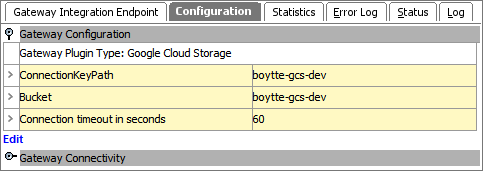
Assets can be delivered to Google Cloud Storage via the Asset Publisher event processor. Data can be delivered by selecting the Google Cloud Storage GIEP when configuring the Cloud Blob Storage delivery method in the Export Manager or an outbound integration endpoint (OIEP). The Cloud Blob Storage delivery method has been updated to include a zip option to group and compress the content; it also allows integration with Azure Blob Storage and AWS S3 Storage.
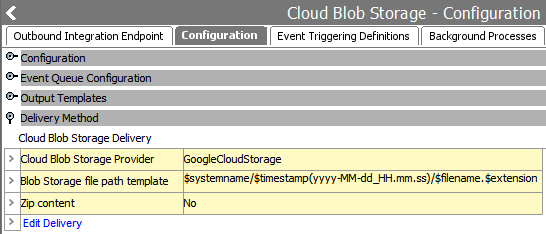
For information on the new GIEP plugin, refer to the Configuring a Gateway Integration Endpoint - Google Cloud Storage topic in the Digital Assets documentation.
For delivery information, refer to the Asset Publisher topic in the Data Exchange documentation, the OIEP Cloud Blob Storage Delivery Method topic in the Data Exchange documentation, or the Export Manager Cloud Blob Storage Delivery Method topic in the Data Exchange documentation.
Support for updated versions of MongoDB
The 'Mongo Delivery (from release 4.2)' delivery method that is available for outbound integration endpoints (OIEPs) now supports delivery to a MongoDB version 5.0 and version 6.0. In a future STEP release, the original 'Mongo Delivery' delivery method will be deprecated and MongoDB versions older than 4.2 will not be supported.
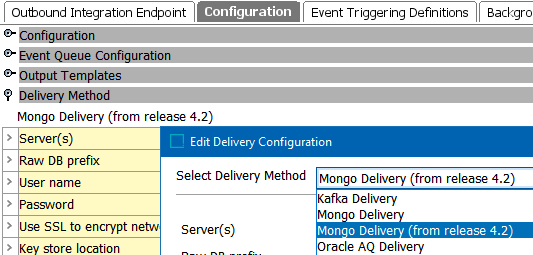
For more information, refer to the Mongo Delivery Method topic in the Data Exchange documentation.
Manage SSL certificates for outbound integration in workbench
Administrators can now use the workbench to fully manage SSL certificates (mTLS and self-signed TLS) for outbound integrations without any system downtime. A new 'SSL Client Certificates' node is available in the System Setup tab that provides full visibility into all configured certificates and their expiration, offers the ability to test if a secure connection to a certain remote URL is possible, and can be used to directly import certificates from remote URLs or files. Furthermore, users can download the mTLS client public key for implementing a mutual trust for outbound integration.
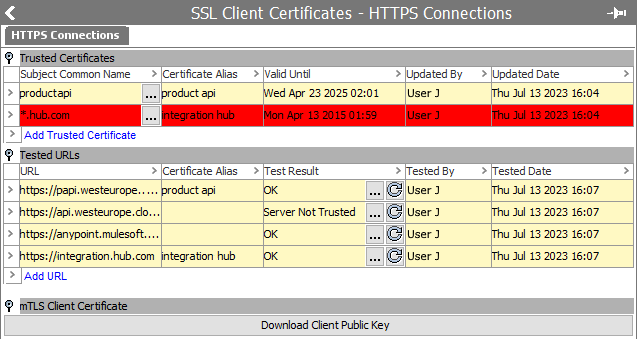
For more information, refer to the SSL Client Certificates topic in the Data Exchange documentation.
Support for latest version of IBM MQ SSL
The existing 'IBM Websphere MQ SSL Delivery' method and the 'IBM Websphere MQ SSL Receiver' option have been renamed to remove 'Websphere' in keeping with a name change by IBM. The newly named 'IBM MQ SSL Delivery' and 'IBM MQ SSL Receiver' options are updated to use the latest supported version (version 9.3.3.0) of IBM MQ.
For information on working with IBM MQ, refer to the IBM MQ SSL Delivery Method topic and the IBM MQ SSL Receiver topic, both in the Data Exchange documentation.
IIEP Kafka Receiver updated with access to all metadata
The existing Kafka Receiver option in an inbound integration endpoint (IIEP) now has access to the message metadata from ConsumerRecord. This means that all available metadata is now accessible. Customers can extend the IIEP functionality with a custom pre-processor to include additional logging and identification of the Kafka message processed in a specific background process.
For more information, refer to the Kafka Receiver topic in the Data Exchange documentation.
OIEP and IIEP Kafka allows OAuth 2.0 bearer tokens
SASL / OAuth 2.0 can now be configured for STEP with Kafka to authenticate securely via bearer tokens. With this release, a business function allows integration with the existing Kafka Receiver for inbound integration endpoints (IIEPs) and the Kafka Delivery method for outbound integration endpoints (OIEPs). The business function handles the OAuth authentication and returns a HashMap containing the Bearer Token and other details.
This functionality requires the following new sharedconfig.properties entries:
-
Kafka.Delivery.[OIEP_ID].ExtraDriverOptions - to indicate the OIEP ID.
-
Kafka.Receiver.[IIEP_ID].ExtraDriverOptions - to indicate the IIEP ID.
-
stibo.authentication.function - to set the JavaScript business function ID.
-
security.protocol - to indicate either SASL_PLAINTEXT (while testing) or SASL_SSL (in production) for the SSL transport layer.
For details on configuration, refer to the Kafka Receiver topic and the Kafka Delivery Method topic in the Data Exchange documentation.
New property restricts user creation with known passwords
Importing new users via STEPXML has allowed including an initial known password, which is useful during development and testing. However, in a production system, it exposes a security risk since access to the STEPXML file also gives access to STEP via the specified usernames and passwords. Now, by default, passwords provided in a STEPXML import file are ignored on import and instead, a temporary password (not known to anyone) is created. Temporary passwords must be reset by the user or by the administrator if STEP manages passwords.
To resolve the security risk in production systems and to follow the recommended practice, the new case-sensitive Import.Users.PasswordIgnored property in the sharedconfig.properties file is set to 'true' by default. For development and testing systems, as needed, set the property to 'false' to allow bulk creation of users with specified passwords via a STEPXML import.
For more information, refer to the Working with Users topic in the System Setup documentation.
BMEcat Version Updates
With progressing globalization, increasing quantity of product data, and constantly diminishing product lifecycles, there is a growing market requirement for information through the use of industry standards such as BMEcat.
It is now possible to export BMEcat 2005 and BMEcat 2005.1 in multiple languages and have a default language. Previously, it was only possible to correctly export in one selected language. Now, users are able to customize their exports to include proper tags for multiple context languages, as well as designate a default language. This eliminates the need for manual data entry or the use of multiple systems, and manufacturers can now easily share their product information with a wide range of partners.

Additionally, with BMEcat 2005, users are able to select a standard and an associated template to use when exporting to support industry standards for ECLASS and ETIM. Previously, users only had a generic default template provided that did not always cover all user needs, and they were not able to select a standard. This often forced users to contact support for help. Now, with the ability to create and upload as many templates as needed and associate them with standards, such as ECLASS or ETIM, users have control of how they export configured data with BMEcat 2005. This saves time by enabling users to already have templates to select from that support industry standards for ECLASS and ETIM and eliminates the need to contact support for data transformation.
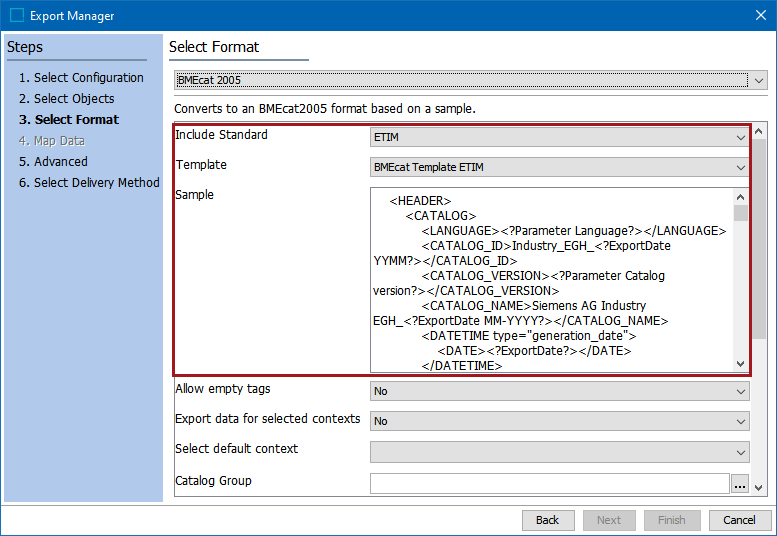
BMEcat 2005 and BMEcat 2005.1 have also been aligned and improved to support industry standards for both import and export for ETIM and ECLASS. The following has been updated:
-
Export of the classification hierarchy is now available in BMEcat 2005
-
'Attributes Inherited from Classification' is available for BMEcat 2005
-
The Price list (term list) option is now available in BMEcat 2005.1
-
The 'Self-contained' option is available in BMEcat 2005.1
-
The 'Feature price' option is now available for BMEcat 2005.1
These updates allows users to serve their customers with product data that is structured uniformly, prevents customization, accelerates time-to-market, and improves data quality through the use of industry standards.
Using BMEcat functionality requires the enablement of commercial licenses. Contact your account manager or partner manager to begin the process of enabling a license or licenses for your system.
For more information, refer to the BMEcat Format topic, the BMEcat 2005 Format topic, and the BMEcat 2005.1 Format topic in the Data Exchange documentation.
Improvements to ECLASS Advanced Editor Screen
The ECLASS Advanced Editor Screen has undergone the following enhancements and updates:
-
Enhanced User Interface: The UI has been updated to highlight important elements in the data model, Blocks, aspects, and cardinality attributes.
-
Functionality Consolidation: To ensure seamless navigation and enriched usability, existing functionalities 'Remove link,' 'Approve ECLASS,' and 'Link to ECLASS Advanced' have been conveniently consolidated and are now accessible through the toolbar.
-
New functionality: With the new Duplicate toolbar action it is now possible to duplicate either the entire product or specific aspects or block structures. This functionality can be used to duplicate internally on the products or to other products.

For more information, refer to the ECLASS Advanced Editor Screen topic in the Web User Interfaces documentation.
PDX Channels in Instrument
Instrument now allows users to view, add, and remove PDX channels for one or more products in a perspective table view. This will enable Category Managers to easily check if products are assigned to the desired PDX channels. If the products have not been assigned to the desired PDX channels, the Category Manager can add or remove PDX channels to ensure that products will be syndicated to the correct receivers via PDX. Furthermore, the PDX Channel solution in Instrument supports business processes to be executed before the actual syndication takes place. This is triggered via a Business Action that will run when channels are either added or removed.
For more information, refer to the PDX Syndication documentation. For more information on Instrument, refer to the Instrument Documentation that is included when Instrument is enabled on a system. It is located on the Start Page under Resources.